ELECTRIC VEHICLES ARE BECOMING available in almost every vehicle category, and the latest, which Nissan describes as its first all-electric crossover SUV, premiered globally through a virtual event hosted at the soon-to-open Nissan Pavilion in Yokohama.
The Ariya offers powerful acceleration and smooth, quiet operation. Its stress-free autonomous driving features, assistance and seamless connectivity heighten on-road confidence and provide a welcoming environment for the driver and passengers. And with an estimated range of up to 610km, Ariya is the perfect partner for daily commutes and road trips alike.
The Nissan Ariya is heavily based on the similarly-named concept vehicle displayed at the 2019 Tokyo Motor Show. It’s the first production model to represent Nissan’s new electrified brand identity.
Built on an all-new Alliance-developed EV platform, the Ariya is the ultimate expression of the company’s strategy to achieve the ultimate goal of a future with zero emissions and zero vehicle fatalities.
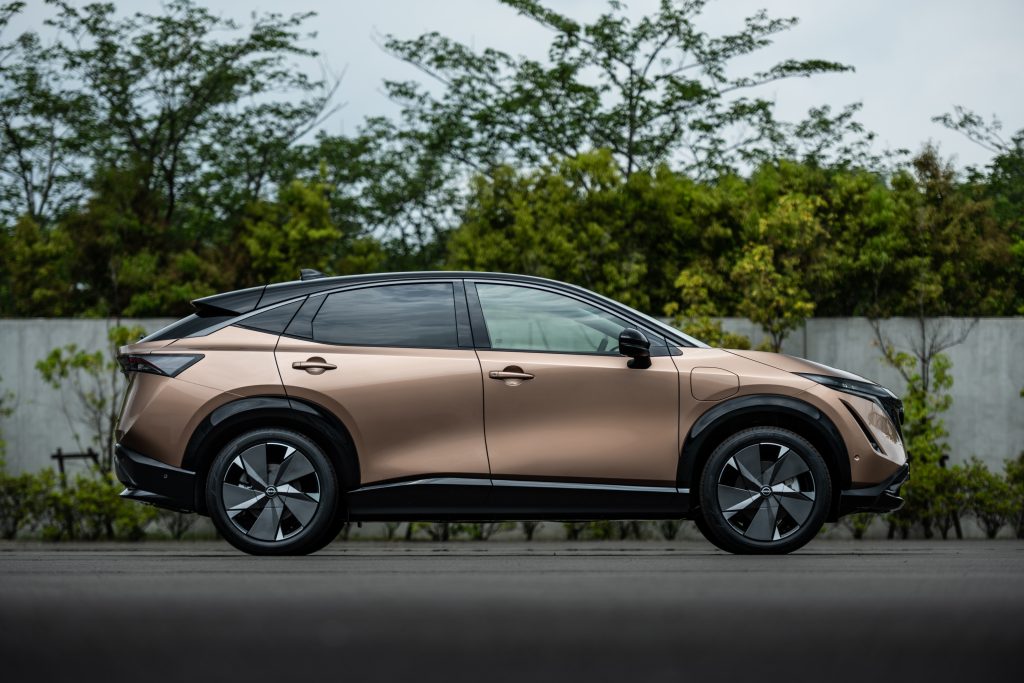
Design: a completely reimagined appearance
The styling represents the Ariya’s first Nissan Intelligent Mobility “touchpoint,” signalling a significant redefinition of Nissan’s design philosophy.
Embracing the Japanese term iki, the front of the vehicle appears elegant and fresh. It’s highlighted by a shield – a reimagined grille for the EV era. The shield, incorporating a 3-D, traditional Japanese kumiko pattern just under the smooth surface, protects sensing equipment used for ProPILOT functions and Intelligent Key detection without the aesthetics interrupting operation.
Nissan’s redesigned brand logo, composed of 20 LEDs, is prominently placed at the centre of the aerodynamic shield.
The lower section of the shield is bordered by subtle lighting that illuminates, along with the logo, when the Ariya is ready for operation. Thin LED headlamps, constructed with four 20mm mini-projectors, are combined with sequential turn signals to reinvent Nissan’s signature V-motion design.
When viewed from the side, the Ariya shows a low, sleek roofline, along with sporty, five-spoke, 19-inch aluminium wheels (20-inch wheels also available, depending on the grade).
A single, uninterrupted line stretches across the side profile, linking the front fascia and the rear.
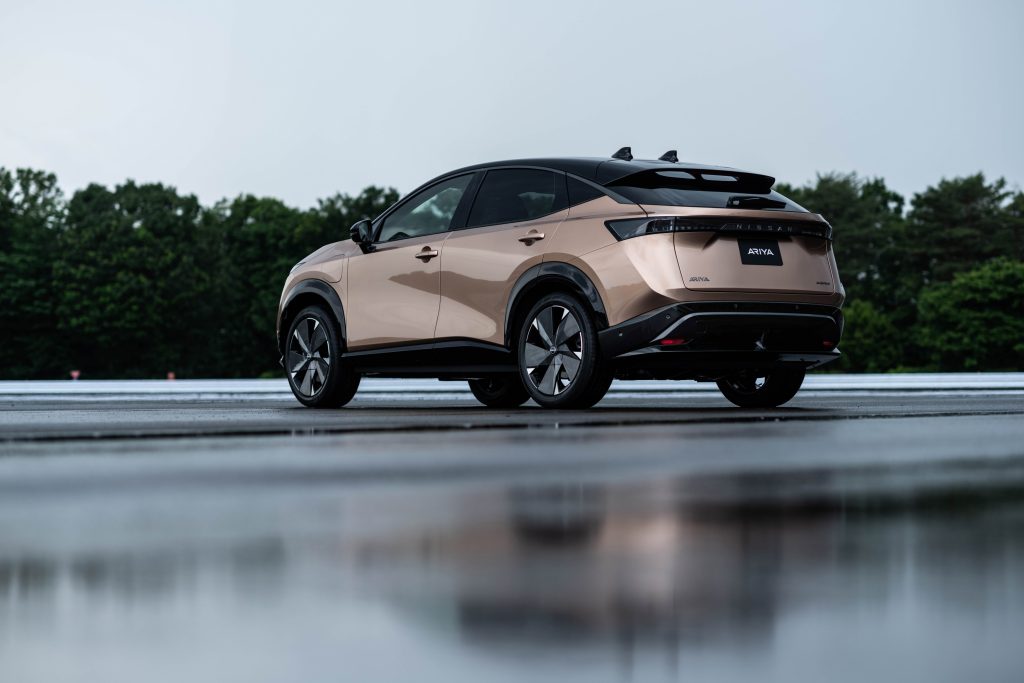
The rear of the Ariya is equally striking, characterized by a steeply raked C-pillar that blends into the rear deck. The one-piece light blade, representing the rear combination lamps, has been engineered to give a blackout effect when parked, and a consistent red illumination, day or night, when in use. Rear fender flares and a high-mounted rear wing hint at the Ariya’s powerful EV capabilities.
“The Ariya’s exterior proportions show what’s possible with Nissan’s 100 percent electric-vehicle platform,” explained Senior Design Director Giovanny Arroba. “The surprisingly short overhangs, aggressive roofline and large wheels provide an elegant appearance that flawlessly balances sport and luxury.”
A newly-developed exterior two-tone colour package (Akatsuki), a combination of copper with a black roof, highlights flowing nature and movement.
Along with Akatsuki, the Ariya is offered with nine two-tone combinations, each sporting a black roof, and five striking full-body colour combinations.
The cabin of the Ariya has been designed in the most efficient and comfortable way. The advantages provided by the company’s all-new EV platform have enabled the Ariya to offer the most spacious cabin in its class. The compact nature of the powertrain components made it possible for Nissan’s engineers to install the climate control system under the bonnet (where a traditional gasoline engine would be), allowing the designers to utilize the whole length of the cabin without obstructions, such as a transmission tunnel or cabin systems tucked under the instrument panel. Also, a flat, open floor – made possible by the location of the battery at the base of the chassis – and the Ariya’s slim profile Zero Gravity seats result in vast amounts of legroom and easy interaction between front- and rear-seat passengers. The quiet EV drivetrain and the generous use of sound-absorbing materials result in an exceptionally quiet cabin.
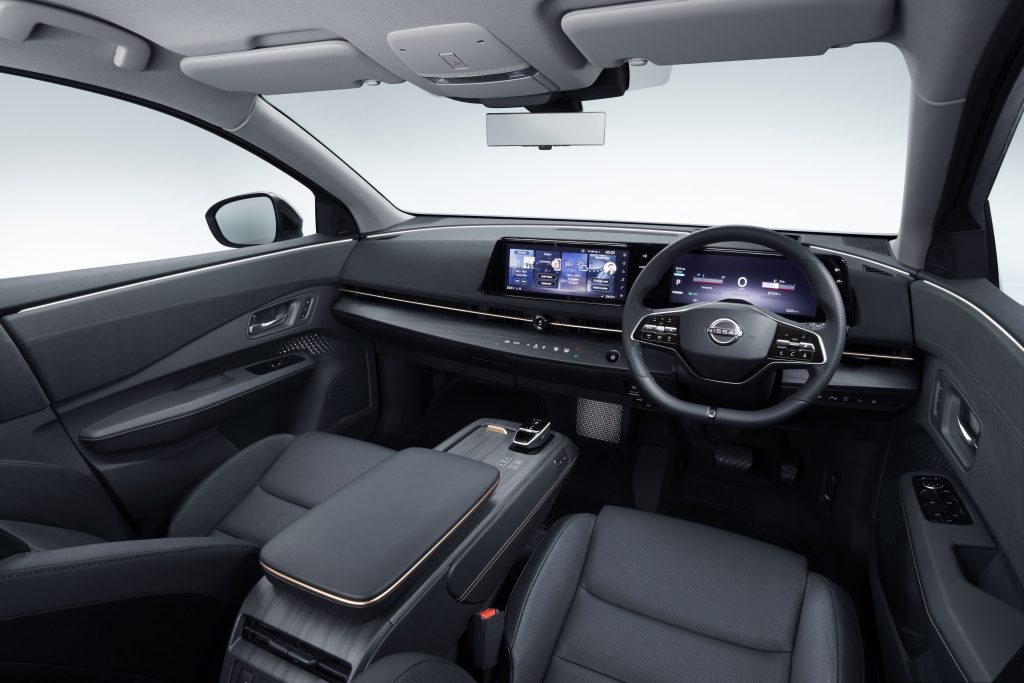
Front-seat occupants are treated to the Ariya’s minimalist dashboard, which blends seamlessly with the shape of the cabin, transitioning into the doors. It’s devoid of buttons and switches found in conventional vehicles. Primary climate control functions are integrated into the wooden centre dash in the form of capacitive haptic switches that offer the same feeling as mechanical switches by vibrating when touched.
Tucked under the centre of the instrument panel is an innovative centre storage box and foldout tray. The innovative slide-out table design transforms the cabin space into a mobile office or can be used as an on-the-go picnic table.
The adjustable centre console can be moved to suit the driver’s personal preference, and the settings can be saved as part of the driver’s profile for automatic adjustment during future outings.
“The interior of the Ariya is a pleasant ‘living space’ for the driver and occupants to enjoy while experiencing the theatre of traveling to familiar and new destinations,” Arroba said. “The materials throughout the interior were carefully selected to avoid the overly traditional feel of some luxury vehicles, while giving an impression of premium futurism in technology and utility.”
Intelligent Power: formidable EV performance for a wide range of needs
The Nissan Ariya’s all-electric drivetrain is an example of seamless integration of advanced EV technology. It takes the excitement and potential of zero-emission mobility to the next level by integrating excellent power delivery, charging capabilities and extended range.
With four core models offered, including two-wheel-drive and all-wheel-drive versions, the Ariya meets the driving needs of a wide range of customers.
The Ariya two-wheel-drive model with 63kWh of usable battery capacity is ideal for urban commuters and first time EV owners looking for quality and style in their next-generation EV. The Ariya two-wheel-drive model with 87kWh of usable battery capacity offers a larger battery, delivering additional range for those looking to venture on longer journeys.
The Ariya e-4ORCE all-wheel-drive model with 63kWh of usable battery capacity offers a balance of performance and value. With slightly less emphasis on range, this model offers ample performance and innovative new technologies, including twin electric motors and e-4ORCE control technology that deliver balanced, predictable power to all four wheels, equal to or better than many premium sports cars. The Ariya e-4ORCE all-wheel-drive model with 87kWh of usable battery capacity features the highest level of Nissan Intelligent Mobility available, including ProPILOT 2.0 which offers hands-off single lane highway driving capability.
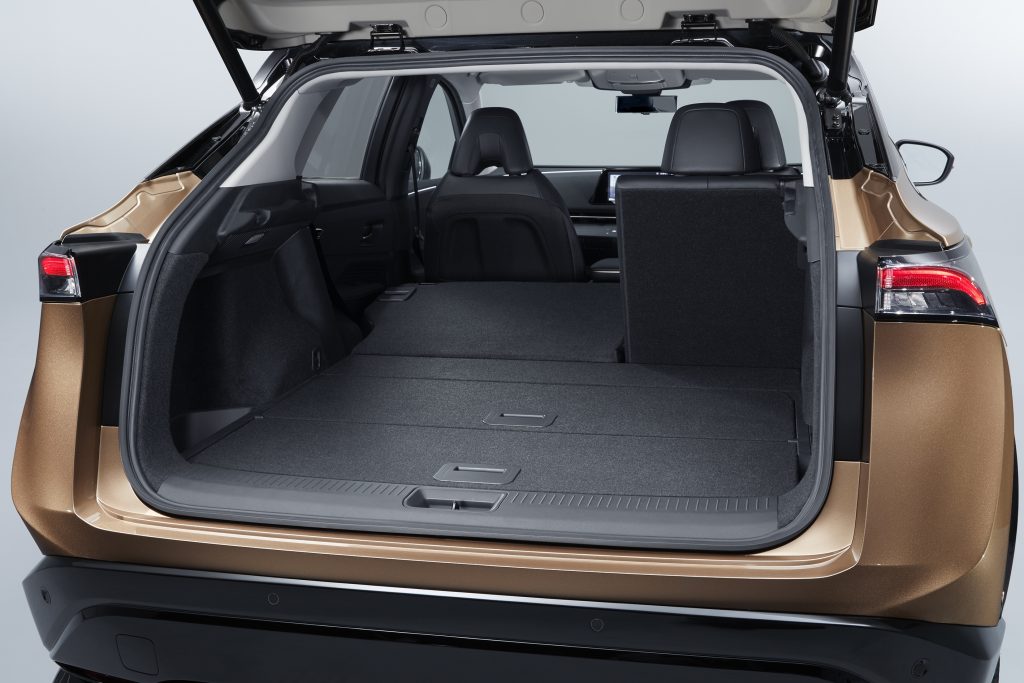
e-4ORCE: Ride comfort and handling without compromise
The twin electric motor, all-wheel-drive Ariya models will feature Nissan’s most advanced all-wheel control technology, e-4FORCE. The “e” in e-4ORCE stands for Nissan’s 100 percent electric motor drive system. “4ORCE” (pronounced force) refers to the vehicle’s physical power and energy, with “4” representing all-wheel control.
By specifically managing power output and braking performance for smoothness and stability, e-4ORCE enhances driver confidence by tracing the intended driving line over almost any road surface, while never needing to change driving style or input. When cornering on snow-covered roads, for example, the vehicle can faithfully trace the driver’s intended line thanks to ultra-high-precision motor and brake control. With the confidence to handle such a variety of road surfaces, driving becomes more enjoyable.
Engineers fine-tuned the e-4ORCE’s precision control technology and twin electric motors to provide unparalleled ride comfort. Vehicle pitch and dive are minimized by adding regenerative rear-motor braking to the usual front-motor regenerative braking employed by typical EV and hybrid systems today.
“By taking advantage of e-4ORCE’s precise motor control response, we’re able to control vehicle motion as soon as the brakes are applied, giving all occupants – especially passengers – a stable, smooth ride,” said Ryozo Hiraku, expert leader of Nissan’s powertrain and EV engineering division.
In addition to optimizing front and rear torque allocation, the system applies independent brake control at each of the four wheels to maximize the cornering force generated by each one. This delivers cornering that faithfully follows driver intentions with minimal steering adjustments.
“The Ariya’s Intelligent Power is one of the pillars that define Nissan’s DNA,” said Makoto Fukuda, development chief product specialist of the Ariya. “There is often talk about EVs and their 0-to-100-kph time, but actually it’s easy for EVs to achieve good acceleration times. The Ariya is also fast in a straight line, but it provides maximum, usable performance in a wide range of driving conditions such as on a snowy mountain road or on wet city streets.”
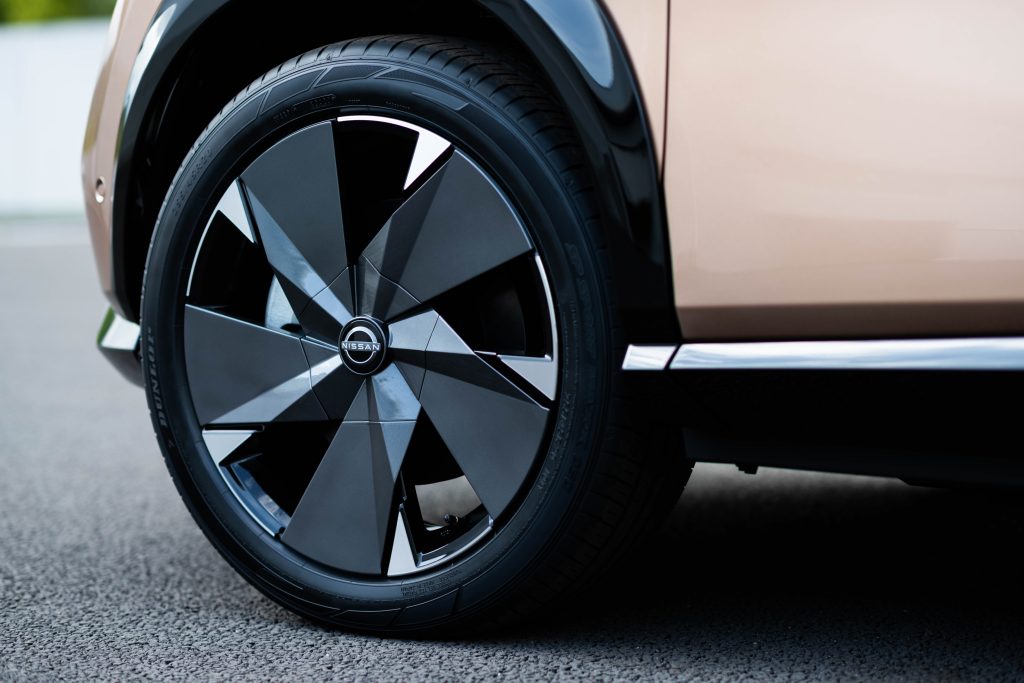
A smooth, powerful on-road presence
The Ariya’s all-new EV platform has been optimized to deliver exceptional handling. The battery pack sits under the centre of the vehicle to ensure a low centre of gravity and near-equal weight distribution, front and rear. The battery pack’s flat design and integrated cross-member in the battery case, allow the Ariya to have a flat floor and impressive structural rigidity. Suspension components are optimized to take advantage of this, ensuring stable handling and a comfortable ride while also suppressing vibrations and noise from entering the cabin space.
In the rear, the suspension packaging, including the multi-link system and rear electric motor (if equipped), create an exceptional balance of ride comfort, handling and performance.
With three drive modes, including Standard, Sport and ECO (e-4ORCE models include an additional Snow mode), drivers have the ability to customize their experience to match their mood and surroundings. The Ariya’s highly rigid body structure and super responsive rack-and-pinion steering system provide the vehicle with crisp turn-in response, while its near 50:50 front/rear weight distribution – made possible by the battery positioned under the floor in the middle of the vehicle – helps the Ariya behave in a predictable manner through all types of corners. The underbody’s flat, aerodynamic nature assists with a stable ride while a tight turning radius adds to the Ariya’s capability not only on the highway, but also narrow streets and parking.
The Nissan Ariya also features driver assistance technology that have been enjoyed by hundreds of thousands of drivers around the globe. e-Pedal, first introduced in the Nissan LEAF electric car, allows the driver to launch, accelerate and decelerate using only the accelerator pedal. e-Pedal works by initiating the electric motor to start the deceleration process of the vehicle when easing off the accelerator pedal. On low-traction surfaces, the brakes are applied simultaneously with the motor, allowing all four wheels to safely slow down the vehicle. On models equipped with e-4ORCE, regenerative torque is distributed to both the front and rear wheels.
Every Ariya model will feature remarkable range recovery and quick-charge performance. This is thanks in part to its battery thermal control feature, which constantly optimizes the operating temperature of the liquid-cooled battery. Using peak 130kW charging, the Ariya can recover up to 375km with a 30-minute quick charge using the CHAdeMO charging system. (Japan specification and charging system capable of 130kW charging, estimation subject to homologation and environmental and battery conditions).
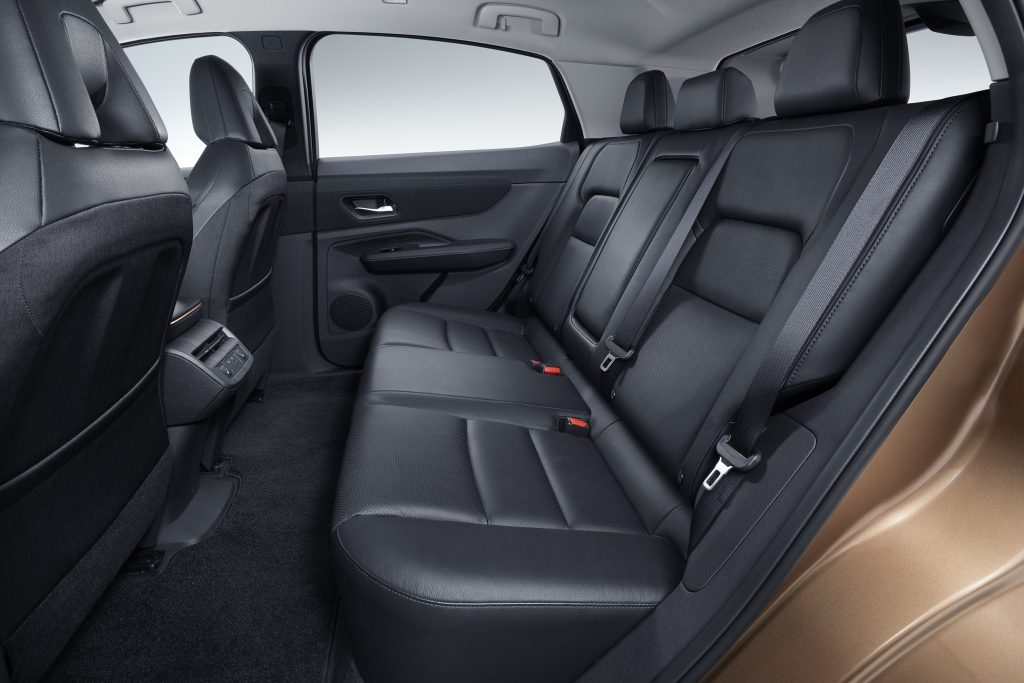
Intelligent Driving: a high-tech, low-stress driving experience
The Ariya ensures high levels of comfort and confidence by providing occupants with the latest Nissan technologies, including ProPILOT 2.0 advanced driver assistance and ProPILOT Remote Park .
ProPILOT 2.0 is the newest iteration of Nissan’s driver assistance technology. Equipped as standard on the second generation Nissan LEAF, ProPILOT is a hands-on assistance system that helps drivers stay centred in their lane, navigate stop-and-go highway traffic and maintain a set vehicle speed and distance to the vehicle ahead. ProPILOT 2.0 expands on this, allowing attentive drivers to take their hands off the steering wheel under certain conditions, reducing the driver’s workload and stress in single-lane highway traffic. In addition, ProPILOT 2.0 also supports multi-lane highway driving tasks such as lane changes, passing and highway exiting.
Intelligent Integration: keeping the Nissan Ariya up-to-date and at maximum potential
The Ariya embodies Nissan’s philosophy of designing vehicles around the driver, making them both intuitive and exciting. This includes equipping it with the latest in connectivity, including a new human-machine interface and firmware updates over the air. Nissan’s intelligent personal assistance technology features a hybrid voice recognition system with advanced natural language understanding technology to handle in-vehicle assistance without the driver taking their eyes off the road.
The display interface features both a 12.3-inch instrument monitor and 12.3-inch centre display along a single horizon. By displaying multiple facets of information on one horizontal plane, information can be quickly digested without the driver being distracted from the road. The two displays are oriented in a wave-like shape to ensure important vehicle information, such as battery information, range and navigation, can be easily reached and scrolled through with a simple swipe. Further information can be swiped between the displays to customize and prioritize the information displayed just behind the steering wheel for an unparalleled bespoke experience.
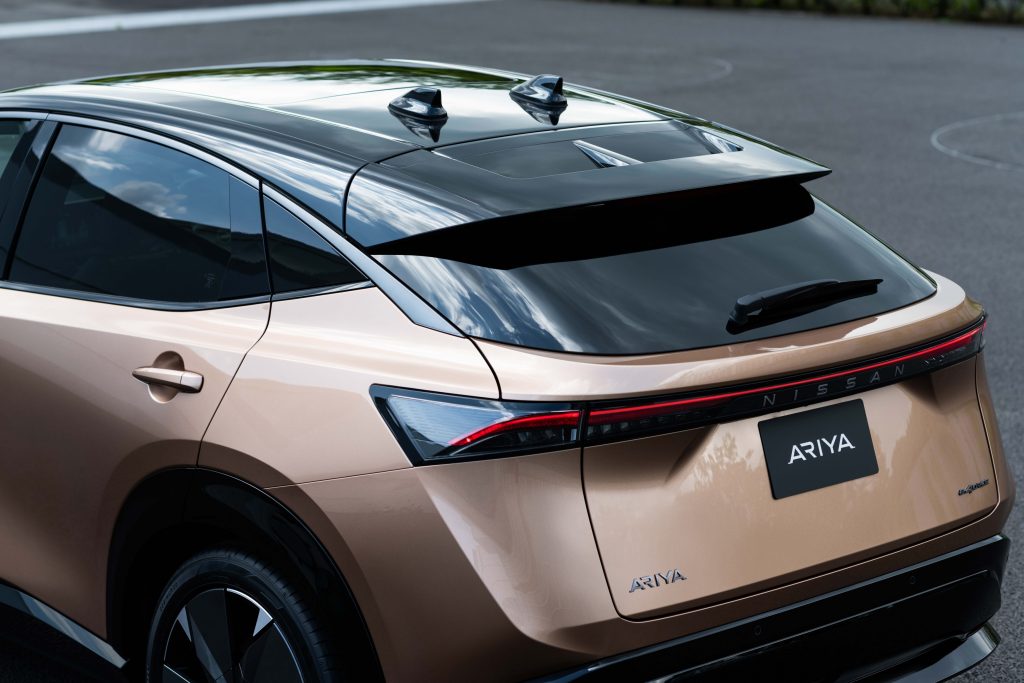
The Ariya’s head-up display boasts one of the largest full-colour displays in the segment. The projected display shows similar information found in the meter display, providing crisp, driving information within the driver’s field of vision without being distracting.
On the drive home, Alexa can be invoked to perform vehicle-to-home functions, including turning on interior home lighting or opening the garage door.
“Nissan’s intelligent personal assistance technology is an expression of omotenashi – the Japanese custom of respecting the customer to the highest degree,” Fukuda said. “It provides a seamless experience, both off- and on-board. The Ariya supports your lifestyle whether from home or on the go.”
The Ariya is also the first Nissan model with firmware updates over the air, called Remote Software Upgrade. The technology automatically updates various software inside the vehicle – specifically, software that controls the multimedia system, electric and electronic architecture, chassis, climate system and EV settings – without having to take the vehicle to a service centre. With periodic real-time updates, the Ariya is always operating at its full potential. A dual-bank memory system even allows for updates while on the go. Updates are downloaded and stored in a separate memory bank. When the system has confirmed the download, it switches to the updated memory bank. Updates are applied quickly and easily, making updates and new feature integration a seamless experience.
The Nissan Ariya will begin delivery in Japan from mid-2021 with an estimated starting price of around 5 million yen.
| Japan-market specifications | Ariya (2WD) | Ariya (AWD) | ||
| Battery capacity
*Battery capacity estimated; subject to homologation |
65 kWh
(nominal) 63 kWh (usable) |
90 kWh
(nominal) 87 kWh (usable) |
65 kWh
(nominal) 63 kWh (usable) |
90 kWh
(nominal) 87 kWh (usable) |
| Output | 160 kW | 178 kW | 250 kW | 290 kW |
| Torque | 300 Nm | 300 Nm | 560 Nm | 600 Nm |
| Acceleration (0-100 Km) | 7.5 sec. | 7.6 sec. | 5.4 sec. | 5.1 sec. |
| Top speed | 160 km/h | 160 km/h | 200 km/h | 200 km/h |
| Estimated range
*Estimation based on WLTC Japan cycle; subject to homologation |
Up to 450 km | Up to 610 km | Up to 430 km | Up to 580 km |
| Length | 4595 mm | |||
| Width | 1850 mm | |||
| Height | 1655 mm | |||
| Weight
(depending on model and equipment) |
1900 kg – 2200 kg | |||
| Wheelbase | 2775 mm | |||
| Luggage capacity | 466 L (2WD) / 408 L (AWD) | |||
| Tire size
(front and rear) |
235/55R19
255/45R20 (available as an option) |
|||
NOTE: The above specifications are as of July 2020 and are subject to homologation. Model names, features and specifications may vary by market.
